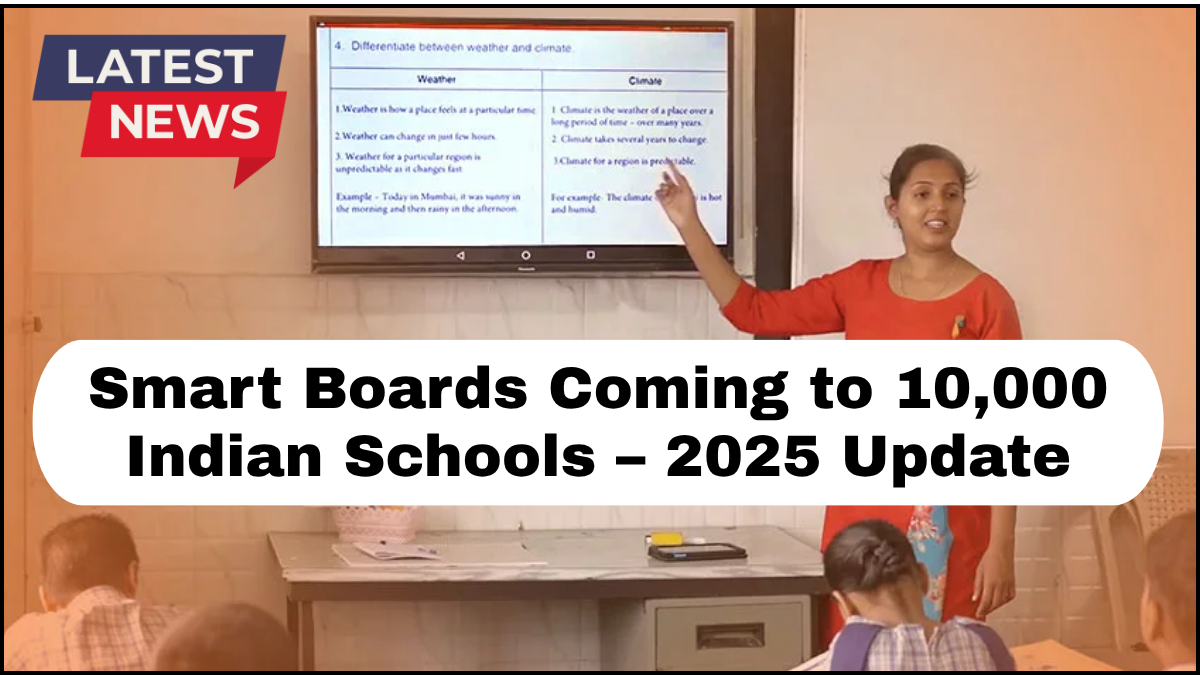India is taking a major leap forward in education technology with the rollout of Smart Boards in Schools across 10,000 institutions in 2025. This initiative, part of the broader Digital India campaign, marks a significant investment in interactive learning, aiming to modernize classrooms and make education more engaging and effective.

What Are Smart Boards and Why Do They Matter?
Smart Boards, also known as interactive whiteboards, are advanced teaching tools that combine traditional whiteboard functions with the power of digital interactivity. They allow teachers to present multimedia content, annotate directly on digital screens, access online resources, and involve students in real-time collaboration.
These boards replace outdated blackboards and chalk with touch-sensitive displays that support handwriting recognition, multimedia playback, and internet connectivity. In essence, Smart Boards turn every classroom into a dynamic digital learning hub.
Government’s Push Under Digital India
The Smart Boards expansion ties directly into the Digital India initiative—a flagship program aimed at transforming India into a digitally empowered society and knowledge economy. By integrating Smart Boards in Schools, the government seeks to bridge the digital divide and offer students in rural and semi-urban areas access to modern educational resources.
The 2025 update confirms that 10,000 government and aided schools will be equipped with Smart Boards by the end of the year. These schools will be selected based on infrastructure readiness and a priority list focusing on underserved districts.
Enhancing Learning Through Technology
The integration of Smart Boards offers several educational advantages:
1. Interactive and Engaging Lessons
Teachers can present concepts using animations, videos, diagrams, and interactive quizzes. This not only makes learning more visual but also helps students retain information better. Subjects like science and math benefit greatly from visual demonstrations.
2. Real-Time Collaboration
Students can solve problems directly on the board, participate in interactive games, or respond to polls. These features foster group discussions and collaborative problem-solving.
3. Access to Digital Content
Smart Boards are often linked to learning management systems (LMS), allowing access to e-books, sample papers, video lectures, and government-approved content. This is particularly useful for standardized learning across regions.
4. Teacher Training and Ease of Use
The program includes training sessions for teachers to make full use of Smart Board technology. These workshops cover lesson planning, content integration, and troubleshooting to ensure educators are comfortable and confident in using the tools.
Regional Impact and Inclusivity
The distribution of Smart Boards is not limited to metropolitan cities. The government aims to ensure inclusion by focusing on:
-
Rural Schools: Providing digital infrastructure where access to quality education is still limited.
-
State Language Support: Ensuring content is available in multiple Indian languages to reflect regional diversity.
-
Special Education: Adapting content for children with learning disabilities or special needs.
Long-Term Goals and Future Expansion
The 2025 Smart Board deployment is just the beginning. The Ministry of Education has hinted at scaling the program further to cover 50,000 schools over the next five years. This aligns with the National Education Policy (NEP) 2020, which emphasizes tech-driven, inclusive, and learner-centered education.
Additionally, collaborations with edtech companies are being explored to offer customized content, AI-driven assessments, and personalized learning pathways for students.
FAQs
What is the main purpose of installing Smart Boards in Schools?
The primary goal is to modernize classrooms and make learning interactive and engaging. It supports Digital India’s mission to digitize core educational infrastructure.
Are Smart Boards being introduced only in private schools?
No. The 2025 update specifically targets government and aided schools, especially in underdeveloped districts, to ensure equal digital access across social and geographic boundaries.
Will teachers be trained to use Smart Boards?
Yes. A structured training program is part of the initiative, helping teachers adapt to and leverage the technology effectively.
How are Smart Boards different from projectors?
Unlike projectors, Smart Boards are interactive, touch-sensitive devices. They allow users to write, draw, and manipulate content directly on the screen.
What subjects benefit most from Smart Board use?
Subjects that involve diagrams, experiments, calculations, and real-time visuals—such as science, mathematics, and geography—are particularly enhanced through Smart Boards.
click here to learn more